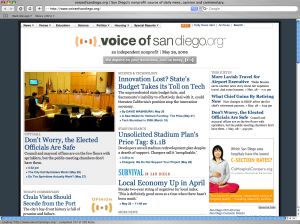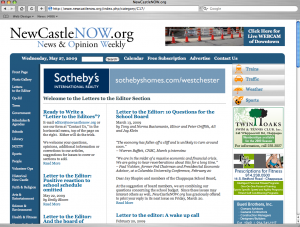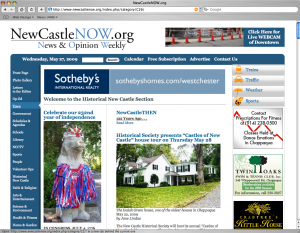 Start Here |
 Ch. 1: Funding Fit |
 Ch. 2: Impact |
 Ch. 3: Success |
 Search Database |
 See Videos |
Civic Impact Case Studies
Case Study
The Voice of San Diego
Pioneering In-Depth Local Journalism
By 2004, Buzz Woolley’s concerns about the kinds of news and information San Diego residents were getting had reached a critical point. So the philanthropist and venture capitalist decided to do something about it.
He talked to professional journalists, researched the possibilities and made a personal investment: He launched an investigative news Web site, the Voice of San Diego. Since its start-up, the site has been making a name for itself not only in the city, but also in the vanguard of online journalism.
“People really didn’t have very good information and I think some very bad decisions were made because of that,” Woolley said.
As a result of the Web site’s in-depth reports, public officials have been fired or resigned, criminal investigations have been launched, development projects have been scrapped and the city’s stewards have been held to new levels of accountability.
Now the site’s journalists can see who’s reading and making decisions based on Voice reports, said Woolley, who has invested $1.3 million in the venture so far.
 By mid-2009, the site’s annual budget had in- creased to $1 million - built mostly from foundation grants, corporate sponsors and donors. Woolley’s private foundation provides some back-office and payroll support, in addition to grants. And the San Diego Foundation gives the 11-person newsroom a deal on rent in its building as well as funding.
By mid-2009, the site’s annual budget had in- creased to $1 million - built mostly from foundation grants, corporate sponsors and donors. Woolley’s private foundation provides some back-office and payroll support, in addition to grants. And the San Diego Foundation gives the 11-person newsroom a deal on rent in its building as well as funding.
The site doesn’t try to cover everything the city’s daily newspaper does. Instead, it focuses intensely on six areas, said the site’s editor and its CEO, Andrew Donohue and Scott Lewis. Those core areas are: Politics, Education, Survival in San Diego (which includes housing, jobs and the local economy), Public Health (including the environment), Public Safety, and Science and Technology.
Local foundations have noticed that efforts around their key issues don’t have much value if people don’t know about them. So the site has attracted a grant to increase coverage of science and technology and another to expand K-12 education coverage. “Neither of those foundations told us what to write,” Lewis said. “They’ve just told us what they would like us to put an emphasis on.”
Distinguishing Voice of San Diego reporting have been award-winning investigations of city pension scandals and clandestine bonuses paid to officials of a redevelopment agency.
The site’s professional journalists also report on issues with imaginative enterprise.
When Voice reporter Rob Davis pulled records on how much water city officials were using, one City Council member was found to be consuming almost a million gallons a year - an eye-popping amount for a city that must import most of its water and where conservation is a regional mantra. Davis also examined high water usage among top business and government agencies, and his reports made clear that if the city’s goal is water conservation, officials will have to “incentivize it differently,” Lewis said.
“It’s an alternative way of presenting what is a long-standing issue in San Diego,” Lewis said. “And it’s something that the local newspapers simply had never thought of.”
Voice reporters regularly use their blogs to ask readers to weigh in with their knowledge or questions about an issue.
One questioner asked how many press people the new mayor had hired. The Voice of San Diego discovered that the number of press officers was at an all-time high. That story helped pave the way, Donohue said, for ongoing reports on “the way the mayor uses the media to sort of massage his message.”
There’s no money to hire lawyers to shepherd Freedom of Information Act requests, so the Web site’s reporters instead use their blogs to give readers regular updates on their efforts to gain access to public records. “We’ve had readers who have jumped on to these crusades with us and they’ve begun calling public agencies … or people and saying: ‘You know, these are public documents. You have to give them,’” Donohue said.
The Voice has attracted a loyal audience, with 75,000 unique visitors a month. “We’ve learned that the best way to drive readership … is to write better stories and to get more of them,” Lewis said.
Starting in 2009, the site’s efforts are set to expand significantly as a result of The San Diego Foundation’s winning a two-year, $500,000 Knight Community Information grant that targets underserved audiences. The local foundation will contribute $200,000 to the Voice to work with community partners to create digital “story stations” in 18 Native American reservations. The site also will develop a “San Diego-Pedia” feature to catalog the region’s distinguishing characteristics.
Donohue and Lewis are grateful for the support of Woolley and others. “You need somebody who will stick with you as you prove your value to the community,” Lewis said. This year, incoming support will allow Woolley to reduce his backing to 20 percent of the project’s annual budget - down from 25 percent and 30 percent in earlier years.
Woolley sees the site having a positive effect on the community. “We did not start this as an act of journalism or an act of business,” he said. “We did this as a civic effort to provide information to the community.”
Case Study
NewCastleNOW.org
Parlaying Knowledge Into News
Thirty-five miles north of New York, in the well-heeled hamlet of Chappaqua, three stay-at-home moms were struck, again and again, by how their community seemed to come to issues late in the game.
Community concerns about whether to build a new middle school or about how a development would alter local traffic patterns registered as late-breaking crises with residents, who’d express disbelief once they learned what was about to happen, said longtime community volunteer Christine Yeres.
Yeres and two of her fellow activists decided to do something to alert people earlier to town happenings. Emboldened by the start-up of a hyperlocal news site in Deerfield, N.H., the three women figured they could do the same thing for their town of New Castle, population 17,000, which governs the hamlets of Chappaqua and Millwood, N.Y. The town, at best, gets only occasional coverage in The New York Times and a regional newspaper.
In 2007, Yeres, with Susie Pender and Anne Marie Fallon, won a $17,000 grant from J-Lab. A

NewCastleNOW launched with a $17,000 J-Lab grant and now sells ads.
few months later they launched NewCastleNOW.org (New Castle News & Opinion Weekly), which has since become a robust local news venture with considerable impact in its Westchester County community (also home to Bill and Hillary Clinton).
Yeres, Pender and Fallon are typical of many founders of hyperlocal news start-ups: They are older with more time on their hands now that their children are in high school or beyond; well-versed from years of involvement in school and community issues; keen about tracking down truths; impassioned about making community life go well.
“I couldn’t have done this five years ago,” said Pender, whose children are now in high school. “I wouldn’t have had the time for it.”
The three founders, who are all unpaid, do much of the reporting and writing themselves, working late every Thursday night to publish about 20 new articles by early Friday morning.
Pender says she wanted, in part, to hold public officials more accountable.
“I was shocked at how much people in a small town like this were willing to say, ‘Those people know what they’re doing, there’s no reason to question the superintendent of the school board,’” she said by way of example. “The problem is there are things that need to be investigated.”
As the news site has established a reputation for fairness, local officials increasingly have been willing to release information. “The more they cooperate in giving us what we’ve requested, the relationship has grown,” Pender said. “And I think they’re better for it, and I think the [news site] is better for it because we’re getting more information out there.”
The editors are experimenting with how to spell one another in their weekly publishing cycle. When one of them needed a holiday break, the others decided that some of the new content for that week would be simply a listing of all the issues to be considered by the town board. “That was the most-read story that week,” Yeres said.
People often move to Chappaqua for its excellent schools, so school coverage, along with real estate and police blotter items, are top priorities.
“Sometimes we want to be The New York Times and sometimes we want to be the church bulletin.”
— Susie Pender, Editor, NewCastleNOW
“We’re not just delivering news,” Yeres said. “We are making the place where people can find out from one another both what’s happening in our town and what others think.” If an article deserves special attention by the public, the editors might print copies to distribute at the local commuter rail station. But the handout is meant to drive users back to the Web site.
The free site has signed up 3,000 subscribers and counts up to 2,000 unique site visitors each week. In 2008, NewCastleNOW also brought in about $50,000 in local sponsorship advertising. One of Yeres’ neighbors, who has a sales and marketing background, sells the ads and takes a 20 percent commission.
The editors also have cajoled dozens of residents to write for the site - with assurances that they will be edited and not left, as they said, “to hang out there alone.” All submissions go through Pender’s rigorous editing process. A grammar-loving college student, also a volunteer, copyedits every article. The team won’t accept anonymous submissions.
“You scratch any person and, one, they’ve likely got a story and, two, they definitely know something that you don’t know,” Pender said. For instance, a resident who works in professional recruiting is writing a column for people who have lost their jobs.
The editors find the answers to questions that residents used to just speculate about. When a local storefront sat empty for more than a year, people began wondering whether it was the start of tough times for the prosperous town. Pender learned that a bank had rented the space, but that a town zoning issue was holding up the bank’s move-in date.
The news site has had a discernible impact on the area. Since it launched, a challenger has

In 2008, NewCastleNOW brought in about $50,000 in local advertising.
successfully unseated an incumbent in the local school board election - an unheard-of scenario in a town where elected school officials typically serve until they decide to step down.
While the NewCastleNOW team wants to be the eyes and ears for residents who don’t have the time to attend public meetings, the editors also have worked hard to make the meetings more accessible to all. When Yeres pressured the town council to air meetings on the local cable station, a board member feared it would discourage attendance. (“They weren’t in the 21st century,” Pender said.)
The meetings are now carried live. The editors also persuaded town leaders to schedule new business at the beginning of each meeting to allow residents to contribute without having to stay out late on a work night.
Like most founders of community news sites, the editors tread carefully when dealing with emotionally fraught stories. When a man in the community was convicted of shooting his wife, NewCastleNOW decided not to cover the story because the editors were sensitive to the suffering of the couple’s high school-aged daughter. “Sometimes we want to be The New York Times and sometimes we want to be the church bulletin,” Pender said. “In that case we decided to be more like the church bulletin.”
For now, the founders are pleased with community feedback: “I can’t go anywhere without people saying, ‘On Fridays I get my coffee, I get to my computer and I read the whole thing,’” Pender said. “It’s extremely well-read in our community.”
